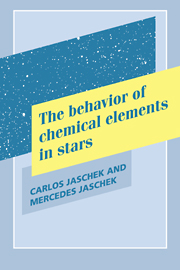Book contents
- Frontmatter
- Contents
- Preface
- Part One Content description
- A Aluminum Al to Arsenic As
- B Barium Ba to Boron B
- C Cadmium Cd to Curium Cm
- D Dysprosium Dy
- E Erbium Er to Europium Eu
- F Fluorine F
- G Gadolinium Gd to Gold Au
- H Hafnium Hf to Hydrogen H
- I Indium In to Iron Fe
- K Krypton Kr
- L Lanthanum La to Lutetium Lu
- M Magnesium Mg to Molybdenum Mo
- N Neodymium Nd to Nitrogen N
- O Osmium Os to Oxygen O
- P Palladium Pd to Promethium Pm
- R Rhenium Re to Ruthenium Ru
- S Samarium Sm to Sulfur S
- T Tantalum Ta to Tungsten W
- U Uranium U
- V Vanadium V
- X Xenon Xe
- Y Ytterbium Yb to Yttrium Y
- Z Zinc Zn to Zirconium Zr
- Summary
- Part Two Content description
- Part Three Content description
- Part Four Content description
- References
- Index of elements in stars
- Index of molecules in stars
I - Indium In to Iron Fe
Published online by Cambridge University Press: 06 July 2010
- Frontmatter
- Contents
- Preface
- Part One Content description
- A Aluminum Al to Arsenic As
- B Barium Ba to Boron B
- C Cadmium Cd to Curium Cm
- D Dysprosium Dy
- E Erbium Er to Europium Eu
- F Fluorine F
- G Gadolinium Gd to Gold Au
- H Hafnium Hf to Hydrogen H
- I Indium In to Iron Fe
- K Krypton Kr
- L Lanthanum La to Lutetium Lu
- M Magnesium Mg to Molybdenum Mo
- N Neodymium Nd to Nitrogen N
- O Osmium Os to Oxygen O
- P Palladium Pd to Promethium Pm
- R Rhenium Re to Ruthenium Ru
- S Samarium Sm to Sulfur S
- T Tantalum Ta to Tungsten W
- U Uranium U
- V Vanadium V
- X Xenon Xe
- Y Ytterbium Yb to Yttrium Y
- Z Zinc Zn to Zirconium Zr
- Summary
- Part Two Content description
- Part Three Content description
- Part Four Content description
- References
- Index of elements in stars
- Index of molecules in stars
Summary
This element was discovered in 1863 in Freiberg, Germany, by F. Reich and H. Richter. The name was chosen because in the spectrum of this element there appears a bright line of indigo color.
lonization energies
InI 5.8 eV, InII 18.9 eV, InIII 28.0 eV.
Absorption lines of InI
The equivalent width of InI 4511 (M.I resonance line) in the sun is 0.004 (Lambert et al. 1969). The In lines are stronger in sunspot spectra. The element is also present in M 2 III stars (Davis 1947).
Emission lines of Inl
InI 4511 appears in emission in long-period variables around maximum light (Merrill 1952, Joy 1954, Deutsch and Merrill 1959).
Behavior in non-normal stars
Cowley et al.(1974) found InII lines in the spectrum of one Ap star of the Cr–Eu–Sr subgroup.
In is enhanced in at least one Ba star (Lambert 1985).
Isotopes
In occurs in two stable forms, In113 and In115. There exist also 32 short-lived isotopes and isomers. In the solar system the frequency of In113 is 4% and that of In115 is 96%.
Origin
In113 is produced by the r, the s or the p process. In115 is only produced by the r process or the s process.
This element was discovered by B. Courtois in Paris in 1811. Its name comes from the Greek iodes (violet).
lonization energies
II 10.4 eV, III 19.1 eV, IIII 33.2 eV.
No I line is observed in the sun. Ionized iodine was found in one Ap star of the Cr-Eu-Sr subgroup by Jaschek and Brandi (1972).
- Type
- Chapter
- Information
- The Behavior of Chemical Elements in Stars , pp. 83 - 93Publisher: Cambridge University PressPrint publication year: 1995

